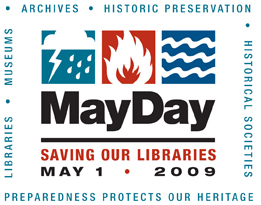 |
Archive for the ‘Suggested Readings’ Category
Wednesday, April 15th, 2009
It’s good to be “on the same page” with an organization like Heritage Preservation! Check out their “Do One Thing” initiative for May Day (May 1) this year. They encourage all libraries and cultural institutions to take some of the same actions the NN/LM is recommending to its members in its “10-Step Approach to Service Continuity,” such as prioritizing collections for rescue, establishing relationships with “buddy” institutions, etc. They also mention that their Disaster Wheel and accompanying Field Guide are on sale at a special price for May Day. These materials have been highly recommended to NN/LM members throughout the training sessions in emergency preparedness and response that have been offered over the past year and a half.
The Heritage site also notes that even though hurricane “season” doesn’t start until June 1, our continent is already experiencing severe weather and flooding, noting that a disaster can happen at any time and in any place. If you visit their site, you might enjoy looking around a bit while you are there. Heritage Preservation (a partner with FEMA) is an excellent resource for all things preservation and recovery for collections. Where the NN/LM emergency preparedness initiative complements Heritage is its focus on service continuity to patrons in terms of providing health related information.

Posted in Disaster Incidents & Hazardous Weather Outlook, Featured Web Site, Flooding, Suggested Readings | No Comments »
Tuesday, March 3rd, 2009
As winter bids us farewell with a few inches of snow and sub-freezing temperatures (increasingly rare here in central Virginia), we note that the likelihood of tornadoes will be increasing as the weather turns warmer. As they say, there is no real tornado “season,” because one can happen any time and in any place, but we see that internet searchers are looking for information on tornado preparedness more often now, so here is some information that we hope will be helpful in preparing for the tumultuous spring weather than can give birth to tornadoes and other severe storms.
As always, the Centers for Disease Control & Prevention web site offers excellent information and advice on tornadoes as part of their Emergency Preparedness and Response information, specifically their Natural Disasters and Severe Weather page. Click on the “Tornado” link for some great information on what you should know and what to do before a tornado, during and afterwards. For instance, what do you think is the most dangerous aspect of a tornado? Where is the most dangerous place to be in a tornado? The answers may surprise you!
Many states will be running tornado preparedness drills in March. Here’s the Virginia site that lists information about the state-wide drill on March 17, as well as how to run a tornado drill. Check out the information on the page about how to find the safest place inside your building to shelter from a tornado.
NOAA weather radios are wonderful to have in your building if you are in an area that is particularly vulnerable to servere storms, or you just want to keep in touch with weather events. They are available with a range of features and at a price range from $25 and up, from a variety of sources. (Amazon lists many models and prices.) Ours has alerted us several times to thunderstorms in the summer, which helped us to be prepared for possible power disruptions and wind/water damage. The NOAA radios receive information continuously from the National Weather Service, and you can set them to sound an alert to your specific area so that the alarm doesn’t sound more often than necessary. Best wishes to everyone for a safe and happy spring season!

Posted in Alerting Systems, CDC, Disaster Incidents & Hazardous Weather Outlook, Drills, Featured Web Site, Hazardous Weather, Severe Storm, Shelter in Place, Suggested Readings, Tornadoes, and Hazardous Weather Outlook | No Comments »
Monday, February 16th, 2009
Logan Ludwig, Director of the Loyola University Chicago’s Health Sciences Library, is also the State Coordinator for Emergency Preparedness for Illinois in the Greater Midwest Region of NN/LM. He has given us permission to post here on the toolkit the Disaster Preparedness and Recovery Manual that he and his colleagues have prepared for their library. The Loyola HSL plan is a great example of a concise one that also covers many bases in terms of both preparedness and response. Check on the “Disaster Plan Templates” page (above) and look in the “Resource Libraries” section for the link to the plan.
Many thanks to Logan for allowing us to view Loyola’s plan, and congratulations on a job well done!

Posted in Disaster Planning, Procedures, Suggested Readings, Toolkit Tips, Writing a Disaster Plan | No Comments »
Tuesday, October 7th, 2008
While we are anticipating the “end” of hurricane season, it’s a good time to take stock of our current situations–are our plans up-to-date? Is it time to start putting a plan together for your library? Do we need to squirrel away some extra supplies, like plastic sheeting or flashlight batteries? We’re fortunate to have so many excellent resources available to help us in our emergency preparedness efforts, and here’s a reminder of two rich sources for guidance and some checklists to keep us on target:
SOLINET: their site has been re-designed. Go to the Resources section, the Preservation tab, then check out the Disaster Resources page, linked in the left side menu bar. Very comprehensive information; I recommend a “shopping” approach if you don’t need the whole store. Some interesting classes coming up, too…I’m taking the one on Risk Management in November.
NEDCC: here’s the link to their page listing all the Preservation leaflets that are available from the site…scroll down on the page to Emergency Management to find their process for disaster planning as well as a “fill-in-the-blank” disaster plan.
Happy shopping!
Posted in Core Resources, Disaster Planning, Featured Web Site, Suggested Readings, Writing a Disaster Plan | No Comments »
Friday, July 25th, 2008
While most of us wouldn’t consider our libraries to be businesses in the traditional sense, we do have some similar features and some shared needs, especially when it comes to planning for business/service continuity. The Homeland Security website has an excellent “Plan to Stay in Business” list for businesses, and if you click on the Continuity Planning link from that page, you will find a more detailed list of activities to help you prepare for an unplanned service disruption. Also available from the Continuity Planning page is their Sample Emergency Plan. It is available in PDF format, which you can quickly fill out right there and then print. Network members will have to do some adapting to make it fit their needs, but it is certainly a great way to help us think through what we need to do. Everyone who has been in any of the training sessions already for the NN/LM Emergency Preparedness & Response Plan will recognize most of what is presented on the Ready.gov site, so the site is helpful as a review, also.
Posted in Business Continuity Planning, Core Resources, Disaster Planning, Featured Web Site, Preparedness, Service Continuity Planning, Suggested Readings, Writing a Disaster Plan | No Comments »
Wednesday, December 5th, 2007
The Virginia Department of Emergency Management (VDEM) has released a new edition of its preparedness toolkit which includes some excellent guidelines for creating a “continuity of operations” (COOP) plan in the event of a pandemic or epidemic. The site has links to directions for creating a manual, and worksheets to walk you through the planning process for service continuity. Take a look for some thought-provoking information for us to consider about keeping our essential services up and running if staff are out with the flu. Thanks, VDEM!
Posted in Business Continuity Planning, Featured Web Site, Pandemics/Epidemics, Preparedness, Suggested Readings | No Comments »
Tuesday, July 10th, 2007
Check this out! Did we think that our procedures are fine for shelter-in-place? Take a look at this document from the “Redefining Readiness” work group, authored by some very well-spoken people from the New York Academy of Medicine. Having any procedure is better than none, I suppose, but the questions raised by this document are as good as “lessons learned” before the event happens! Back to the drawing board we go!
Posted in Bioterrorism, Business Continuity Planning, Disaster Incidents, Disaster Planning, Lessons Learned, Pandemics/Epidemics, Preparedness, Risk Assessment, Shelter in Place, Suggested Readings | No Comments »
Monday, June 25th, 2007
I subscribe to the emailed newsletter from the Virginia Department of Emergency Management, and the one from this past week contained some very interesting information for those of us involved in emergency preparedness particularly in public spaces and hospital settings. Two headlines grabbed my attention right away; one being the the results of a poll taken of people living on the southeast US coast with regard to hurricane preparedness, the other being a post about the OSHA guidelines for pandemic flu preparedness, which seems to have been updated since we reported on it earlier. However, the other posts are also timely, so check it out!
Posted in Hurricanes, Pandemics/Epidemics, Preparedness, Suggested Readings | No Comments »
Wednesday, April 4th, 2007
Check out the March 15, 2007 issue of Library Journal for the article, “Serving Through Disaster.“ It makes an excellent case for the importance of service continuity planning as a key part of any disaster plan. For many Health Sciences libraries, it might be the most important part, as we rely more on timely access to electronic resources than we do on saving books and print journals in an emergency. My favorite quote is by Anne Candreva, CIO of the Brooklyn Public Library, “The question of how quickly we can get back on our feet has turned into how can we make sure to stay there in the first place.”
Posted in Business Continuity Planning, Disaster Planning, Recovery, Suggested Readings | No Comments »
Wednesday, April 4th, 2007
Check out the March 15, 2007 issue of Library Journal for the article, “Serving Through Disaster.“ It makes an excellent case for the importance of service continuity planning as a key part of any disaster plan. For many Health Sciences libraries, it might be the most important part, as we rely more on timely access to electronic resources than we do on saving books and print journals in an emergency. My favorite quote is by Anne Candreva, CIO of the Brooklyn Public Library, “The question of how quickly we can get back on our feet has turned into how can we make sure to stay there in the first place.”
Posted in Business Continuity Planning, Disaster Planning, Recovery, Suggested Readings | No Comments »
|
 |








